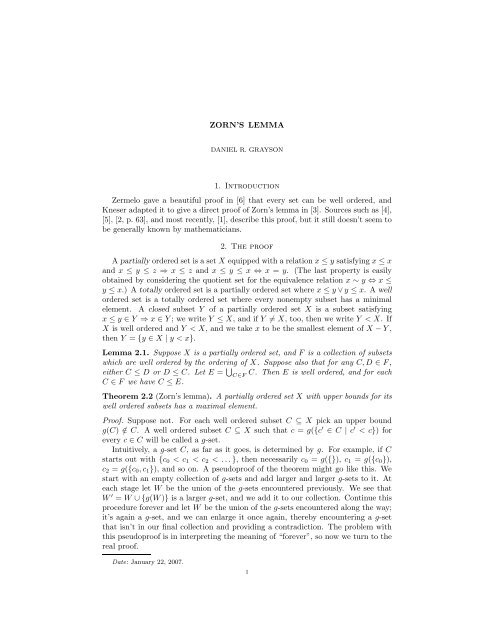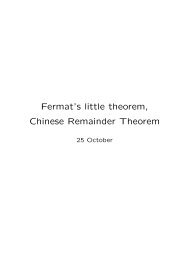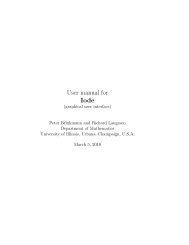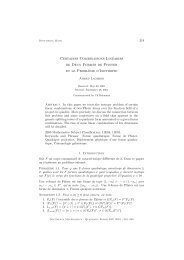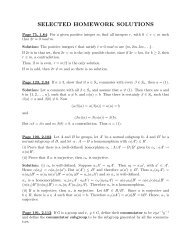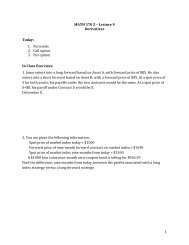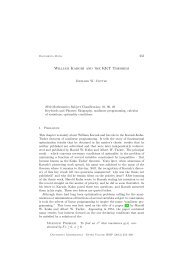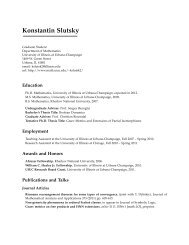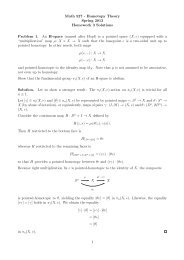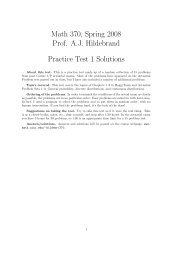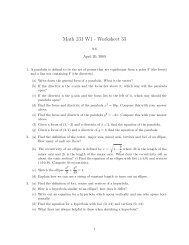ZORN'S LEMMA 1. Introduction Zermelo gave a beautiful proof in [6 ...
ZORN'S LEMMA 1. Introduction Zermelo gave a beautiful proof in [6 ...
ZORN'S LEMMA 1. Introduction Zermelo gave a beautiful proof in [6 ...
You also want an ePaper? Increase the reach of your titles
YUMPU automatically turns print PDFs into web optimized ePapers that Google loves.
ZORN’S <strong>LEMMA</strong><br />
DANIEL R. GRAYSON<br />
<strong>1.</strong> <strong>Introduction</strong><br />
<strong>Zermelo</strong> <strong>gave</strong> a <strong>beautiful</strong> <strong>proof</strong> <strong>in</strong> [6] that every set can be well ordered, and<br />
Kneser adapted it to give a direct <strong>proof</strong> of Zorn’s lemma <strong>in</strong> [3]. Sources such as [4],<br />
[5], [2, p. 63], and most recently, [1], describe this <strong>proof</strong>, but it still doesn’t seem to<br />
be generally known by mathematicians.<br />
2. The <strong>proof</strong><br />
A partially ordered set is a set X equipped with a relation x ≤ y satisfy<strong>in</strong>g x ≤ x<br />
and x ≤ y ≤ z ⇒ x ≤ z and x ≤ y ≤ x ⇔ x = y. (The last property is easily<br />
obta<strong>in</strong>ed by consider<strong>in</strong>g the quotient set for the equivalence relation x ∼ y ⇔ x ≤<br />
y ≤ x.) A totally ordered set is a partially ordered set where x ≤ y ∨ y ≤ x. A well<br />
ordered set is a totally ordered set where every nonempty subset has a m<strong>in</strong>imal<br />
element. A closed subset Y of a partially ordered set X is a subset satisfy<strong>in</strong>g<br />
x ≤ y ∈ Y ⇒ x ∈ Y ; we write Y ≤ X, and if Y = X, too, then we write Y < X. If<br />
X is well ordered and Y < X, and we take x to be the smallest element of X − Y ,<br />
then Y = {y ∈ X | y < x}.<br />
Lemma 2.<strong>1.</strong> Suppose X is a partially ordered set, and F is a collection of subsets<br />
which are well ordered by the order<strong>in</strong>g of X. Suppose also that for any C, D ∈ F ,<br />
either C ≤ D or D ≤ C. Let E = <br />
C∈F C. Then E is well ordered, and for each<br />
C ∈ F we have C ≤ E.<br />
Theorem 2.2 (Zorn’s lemma). A partially ordered set X with upper bounds for its<br />
well ordered subsets has a maximal element.<br />
Proof. Suppose not. For each well ordered subset C ⊆ X pick an upper bound<br />
g(C) /∈ C. A well ordered subset C ⊆ X such that c = g({c ′ ∈ C | c ′ < c}) for<br />
every c ∈ C will be called a g-set.<br />
Intuitively, a g-set C, as far as it goes, is determ<strong>in</strong>ed by g. For example, if C<br />
starts out with {c0 < c1 < c2 < . . . }, then necessarily c0 = g({}), c1 = g({c0}),<br />
c2 = g({c0, c1}), and so on. A pseudo<strong>proof</strong> of the theorem might go like this. We<br />
start with an empty collection of g-sets and add larger and larger g-sets to it. At<br />
each stage let W be the union of the g-sets encountered previously. We see that<br />
W ′ = W ∪ {g(W )} is a larger g-set, and we add it to our collection. Cont<strong>in</strong>ue this<br />
procedure forever and let W be the union of the g-sets encountered along the way;<br />
it’s aga<strong>in</strong> a g-set, and we can enlarge it once aga<strong>in</strong>, thereby encounter<strong>in</strong>g a g-set<br />
that isn’t <strong>in</strong> our f<strong>in</strong>al collection and provid<strong>in</strong>g a contradiction. The problem with<br />
this pseudo<strong>proof</strong> is <strong>in</strong> <strong>in</strong>terpret<strong>in</strong>g the mean<strong>in</strong>g of “forever”, so now we turn to the<br />
real <strong>proof</strong>.<br />
Date: January 22, 2007.<br />
1
2 GRAYSON<br />
We claim that if C and D are g-sets, then either C ≤ D or D ≤ C. To see<br />
this, let W be the union of the subsets B ⊆ X satisfy<strong>in</strong>g B ≤ C and B ≤ D.<br />
S<strong>in</strong>ce a union of closed subsets is closed, we see that W ≤ C and W ≤ D, and<br />
W is the largest subset of X with this property. If W = C or W = D we are<br />
done, so assume W < C and W < D, and pick elements c ∈ C and d ∈ D so that<br />
W = {c ′ ∈ C | c ′ < c} = {d ′ ∈ D | d ′ < d}. S<strong>in</strong>ce C and D are g-sets, we see that<br />
c = g(W ) = d. Let W ′ = W ∪ {g(W )}; it’s a g-set larger than W with W ′ ≤ C<br />
and W ′ ≤ D, contradict<strong>in</strong>g the maximality of W .<br />
Now let W be the union of all the g-sets. It’s a g-set, too, and it’s the largest<br />
g-set, but W ′ = W ∪ {g(W )} is a larger g-set, yield<strong>in</strong>g a contradiction. <br />
References<br />
[1] Akihiro Kanamori. The mathematical import of <strong>Zermelo</strong>’s well-order<strong>in</strong>g theorem. Bull. Symbolic<br />
Logic, 3(3):281–311, 1997.<br />
[2] Irv<strong>in</strong>g Kaplansky. Set theory and metric spaces. Chelsea Publish<strong>in</strong>g Co., New York, second<br />
edition, 1977.<br />
[3] Hellmuth Kneser. E<strong>in</strong>e direkte Ableitung des Zornschen Lemmas aus dem Auswahlaxiom.<br />
Math. Z., 53:110–113, 1950.<br />
[4] T. Szele. On Zorn’s lemma. Publ. Math. Debrecen, 1:254–256, erratum 257, 1950.<br />
[5] J. D. Weston. A short <strong>proof</strong> of Zorn’s lemma. Arch. Math., 8:279, 1957.<br />
[6] Ernst <strong>Zermelo</strong>. Beweis, daß jede Menge wohlgeordnet werden kann. Math. Ann., 59:514–516,<br />
1904.<br />
University of Ill<strong>in</strong>ois at Urbana-Champaign<br />
E-mail address: dan@math.uiuc.edu<br />
URL: http://www.math.uiuc.edu/~dan


